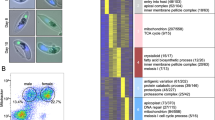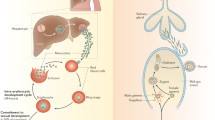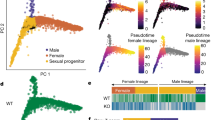Abstract
For Plasmodium falciparum, the most widespread and virulent malaria parasite that infects humans, persistence depends on continuous asexual replication in red blood cells, while transmission to their mosquito vector requires asexual blood-stage parasites to differentiate into non-replicating gametocytes. This decision is controlled by stochastic derepression of a heterochromatin-silenced locus encoding AP2-G, the master transcription factor of sexual differentiation. The frequency of ap2-g derepression was shown to be responsive to extracellular phospholipid precursors but the mechanism linking these metabolites to epigenetic regulation of ap2-g was unknown. Through a combination of molecular genetics, metabolomics and chromatin profiling, we show that this response is mediated by metabolic competition for the methyl donor S-adenosylmethionine between histone methyltransferases and phosphoethanolamine methyltransferase, a critical enzyme in the parasite’s pathway for de novo phosphatidylcholine synthesis. When phosphatidylcholine precursors are scarce, increased consumption of SAM for de novo phosphatidylcholine synthesis impairs maintenance of the histone methylation responsible for silencing ap2-g, increasing the frequency of derepression and sexual differentiation. This provides a key mechanistic link that explains how LysoPC and choline availability can alter the chromatin status of the ap2-g locus controlling sexual differentiation.






Similar content being viewed by others
Data availability
All data needed to evaluate the conclusions in the paper are present in the paper or the supplementary materials. Raw and processed CUT & RUN data can be obtained from the NCBI Gene Expression Omnibus (GSE197916). Source data are provided with this paper.
Code availability
The CUT & RUN analysis pipeline is available at https://github.com/KafsackLab/MetChoH3K9me3.
References
Drakeley, C., Sutherland, C., Bousema, J. T., Sauerwein, R. W. & Targett, G. A. T. The epidemiology of Plasmodium falciparum gametocytes: weapons of mass dispersion. Trends Parasitol. 22, 424–430 (2006).
Kafsack, B. F. C. et al. A transcriptional switch underlies commitment to sexual development in malaria parasites. Nature 507, 248–252 (2014).
Sinha, A. et al. A cascade of DNA-binding proteins for sexual commitment and development in Plasmodium. Nature 507, 253–257 (2014).
Brancucci, N. M. B. et al. Heterochromatin protein 1 secures survival and transmission of malaria parasites. Cell Host Microbe 16, 165–176 (2014).
Fraschka, S. A. et al. Comparative heterochromatin profiling reveals conserved and unique epigenome signatures linked to adaptation and development of malaria parasites. Cell Host Microbe 23, 407–420.e8 (2018).
Lopez-Rubio, J. J., Mancio-Silva, L. & Scherf, A. Genome-wide analysis of heterochromatin associates clonally variant gene regulation with perinuclear repressive centers in malaria parasites. Cell Host Microbe 5, 179–190 (2009).
Coleman, B. I. et al. A Plasmodium falciparum histone deacetylase regulates antigenic variation and gametocyte conversion. Cell Host Microbe 16, 177–186 (2014).
Brancucci, N. M. B., Witmer, K., Schmid, C. & Voss, T. S. A var gene upstream element controls protein synthesis at the level of translation initiation in Plasmodium falciparum. PLoS ONE 9, e100183 (2014).
Filarsky, M. et al. GDV1 induces sexual commitment of malaria parasites by antagonizing HP1-dependent gene silencing. Science 359, 1259–1263 (2018).
Poran, A. et al. Single-cell RNA sequencing reveals a signature of sexual commitment in malaria parasites. Nature 551, 95–99 (2017).
Josling, G. A. et al. Dissecting the role of PfAP2-G in malaria gametocytogenesis. Nat. Commun. 11, 1503 (2020).
Llorà-Batlle, O. et al. Conditional expression of PfAP2-G for controlled massive sexual conversion in Plasmodium falciparum. Sci. Adv. 6, eaaz5057 (2020).
Kent, R. S. et al. Inducible developmental reprogramming redefines commitment to sexual development in the malaria parasite Plasmodium berghei. Nat. Microbiol. 3, 1206–1213 (2018).
Neveu, G., Beri, D. & Kafsack, B. F. Metabolic regulation of sexual commitment in Plasmodium falciparum. Curr. Opin. Microbiol. 58, 93–98 (2020).
Brancucci, N. M. B. et al. Lysophosphatidylcholine regulates sexual stage differentiation in the human malaria parasite Plasmodium falciparum. Cell 171, 1532–1544.e15 (2017).
Pollitt, L. C. et al. Competition and the evolution of reproductive restraint in malaria parasites. Am. Nat. 177, 358–367 (2011).
Joice, R. et al. Plasmodium falciparum transmission stages accumulate in the human bone marrow. Sci. Transl. Med. 6, 244re5 (2014).
Venugopal, K., Hentzschel, F., Valkiūnas, G. & Marti, M. Plasmodium asexual growth and sexual development in the haematopoietic niche of the host. Nat. Rev. Microbiol. 18, 177–189 (2020).
Gulati, S. et al. Profiling the essential nature of lipid metabolism in asexual blood and gametocyte stages of Plasmodium falciparum. Cell Host Microbe 18, 371–381 (2015).
Wein, S. et al. Contribution of the precursors and interplay of the pathways in the phospholipid metabolism of the malaria parasite. J. Lipid Res. 59, 1461–1471 (2018).
Kilian, N., Choi, J.-Y., Voelker, D. R. & Ben Mamoun, C. Role of phospholipid synthesis in the development and differentiation of malaria parasites in the blood. J. Biol. Chem. 293, 17308–17316 (2018).
Garg, A. et al.Structure, function and inhibition of the phosphoethanolamine methyltransferases of the human malaria parasites Plasmodium vivax and Plasmodium knowlesi. Sci. Rep. 5, 9064 (2015).
Witola, W. H. & Ben Mamoun, C. Choline induces transcriptional repression and proteasomal degradation of the malarial phosphoethanolamine methyltransferase. Eukaryot. Cell 6, 1618–1624 (2007).
Ye, C., Sutter, B. M., Wang, Y., Kuang, Z. & Tu, B. P. A metabolic function for phospholipid and histone methylation. Mol. Cell 66, 180–193.e8 (2017).
Prommana, P. et al. Inducible knockdown of Plasmodium gene expression using the glmS ribozyme. PLoS ONE 8, e73783 (2013).
Warrenfeltz, S. et al. EuPathDB: the eukaryotic pathogen genomics database resource. Methods Mol. Biol. 1757, 69–113 (2018).
Dechamps, S. et al. Rodent and nonrodent malaria parasites differ in their phospholipid metabolic pathways. J. Lipid Res. 51, 81–96 (2010).
Mentch, S. J. et al. Histone methylation dynamics and gene regulation occur through the sensing of one-carbon metabolism. Cell Metab. 22, 861–873 (2015).
Li, S. et al. Serine and SAM responsive complex SESAME regulates histone modification crosstalk by sensing cellular metabolism. Mol. Cell 60, 408–421 (2015).
Shyh-Chang, N. et al. Influence of threonine metabolism on S-adenosylmethionine and histone methylation. Science 339, 222–226 (2013).
Ye, C. et al. Demethylation of the protein phosphatase PP2A promotes demethylation of histones to enable their function as a methyl group sink. Mol. Cell 73, 1115–1126.e6 (2019).
Sutter, B. M., Wu, X., Laxman, S. & Tu, B. P. Methionine inhibits autophagy and promotes growth by inducing the SAM-responsive methylation of PP2A. Cell 154, 403–415 (2013).
Morillo, R. C., Harris, C. T., Kennedy, K., Henning, S. R. & Kafsack, B. F. Genome-wide profiling of histone modifications in Plasmodium falciparum using CUT&RUN. Life Sci. Alliance 6, e202201778, (2022).
Salcedo-Amaya, A. M. et al. Dynamic histone H3 epigenome marking during the intraerythrocytic cycle of Plasmodium falciparum. Proc. Natl Acad. Sci. USA 106, 9655–9660 (2009).
Karmodiya, K. et al. A comprehensive epigenome map of Plasmodium falciparum reveals unique mechanisms of transcriptional regulation and identifies H3K36me2 as a global mark of gene suppression. Epigenetics Chromatin 8, 32 (2015).
Reguera, R. M., Redondo, C. M., Pérez-Pertejo, Y. & Balaña-Fouce, R. S-adenosylmethionine in protozoan parasites: functions, synthesis and regulation. Mol. Biochem Parasitol. 152, 1–10 (2007).
Luo, M. Chemical and biochemical perspectives of protein lysine methylation. Chem. Rev. 118, 6656–6705 (2018).
Bujnicki, J. M., Prigge, S. T., Caridha, D. & Chiang, P. K. Structure, evolution, and inhibitor interaction of S-adenosyl-L-homocysteine hydrolase from Plasmodium falciparum. Proteins 52, 624–632 (2003).
Chiang, P. K. Biological effects of inhibitors of S-adenosylhomocysteine hydrolase. Pharmacol. Ther. 77, 115–134 (1998).
Beri, D. et al. A disrupted transsulphuration pathway results in accumulation of redox metabolites and induction of gametocytogenesis in malaria. Sci. Rep. 7, 40213 (2017).
Tibúrcio, M. et al. A switch in infected erythrocyte deformability at the maturation and blood circulation of Plasmodium falciparum transmission stages. Blood 119, e172–e180 (2012).
Neveu, G. et al. Plasmodium falciparum sexual parasites develop in human erythroblasts and affect erythropoiesis. Blood 136, 1381–1393 (2020).
Trager, W. & Gill, G. S. Enhanced gametocyte formation in young erythrocytes by Plasmodium falciparum in vitro. J. Protozool. 39, 429–432 (1992).
Trager, W., Gill, G. S., Lawrence, C. & Nagel, R. L. Plasmodium falciparum: enhanced gametocyte formation in vitro in reticulocyte-rich blood. Exp. Parasitol. 91, 115–118 (1999).
Hentzschel, F. et al. Host cell maturation modulates parasite invasion and sexual differentiation in Plasmodium berghei. Sci. Adv. 8, eabm7348 (2022).
Percy, A. K., Schmell, E., Earles, B. J. & Lennarz, W. J. Phospholipid biosynthesis in the membranes of immature and mature red blood cells. Biochemistry 12, 2456–2461 (1973).
Huang, N. J. et al. Enhanced phosphocholine metabolism is essential for terminal erythropoiesis. Blood 131, 2955–2966 (2018).
Otto, T. D. et al. A comprehensive evaluation of rodent malaria parasite genomes and gene expression. BMC Biol. 12, 86 (2014).
Fougère, A. et al. Variant exported blood-stage proteins encoded by Plasmodium multigene families are expressed in liver stages where they are exported into the parasitophorous vacuole. PLoS Pathog. 12, e1005917 (2016).
McLean, K. J. et al. Generation of transmission-competent human malaria parasites with chromosomally-integrated fluorescent reporters. Sci. Rep. 9, 13131 (2019).
Moll, K., Ljungström, I., Perlmann, H., Scherf, A. & Wahlgren M. Methods in Malaria Research. 5th ed. Malaria Research and Reference Reagent Resource Center (MR4) (2008).
Ballinger, E. et al. Opposing reactions in coenzyme A metabolism sensitize Mycobacterium tuberculosis to enzyme inhibition. Science 363, eaau8959 (2019).
Skene, P. J., Henikoff, J. G. & Henikoff, S. Targeted in situ genome-wide profiling with high efficiency for low cell numbers. Nat. Protoc. 13, 1006–1019 (2018).
Bolger, A. M., Lohse, M. & Usadel, B. Trimmomatic: a flexible trimmer for Illumina sequence data. Bioinformatics 30, 2114–2120 (2014).
Li, H. & Durbin, R. Fast and accurate short read alignment with Burrows-Wheeler transform. Bioinformatics 25, 1754–1760 (2009).
Li, H. et al. The Sequence Alignment/Map format and SAMtools. Bioinformatics 25, 2078–2079 (2009).
Zhang, Y. et al. Model-based analysis of ChIP-Seq (MACS). Genome Biol. 9, R137 (2008).
Quinlan, A. R. & Hall, I. M. BEDTools: a flexible suite of utilities for comparing genomic features. Bioinformatics 26, 841–842 (2010).
Lawrence, M. et al. Software for computing and annotating genomic ranges. PLoS Comput. Biol. 9, e1003118 (2013).
Hahne, F. & Ivanek, R. in Methods in Molecular Biology Vol. 1418 (eds Mathé, E. & Davis, S.) 335–351 (Humana Press, 2016).
Huber, W. et al. Orchestrating high-throughput genomic analysis with Bioconductor. Nat. Methods 12, 115–121 (2015).
Acknowledgements
We thank J. Dvorin (Boston Childrens Hospital) for providing Compound 1, the Weill Cornell Medicine genomics core for technical support, and the Eukaryotic Pathogen, Vector and Host Informatics Resource (VEuPathDB) for providing essential bioinformatics resources. This work was supported by funds from Weill Cornell Medicine (B.F.C.K.), NIH 1R01 AI141965 (B.F.C.K.), NIH 1R01 AI138499 (K.W.D.), NIH 5F31AI136405-03 (C.T.H.), NIH R25 AI140472 (K.Y.R.), the Fundação para a Ciência e Tecnologia (M.M.M., DRIVER-LISBOA-01-0145-FEDER-030751) and ‘laCaixa’ Foundation (M.M.M., under agreement HR17/52150010).
Author information
Authors and Affiliations
Contributions
B.F.C.K., K.W.D. and M.M.M. conceptualized the project; B.F.C.K., C.T.H. and M.M.M. developed the methodology; C.T.H., X.T., R.C., L.N.V., N.N., V.A.Z.-L. and I.M.M. conducted the investigations; C.T.H., B.F.C.K. and X.T. developed software, and conducted formal analysis and data curation; C.T.H. wrote the original draft; B.F.C.K., C.T.H. and M.M.M. reviwed and edited the manuscript; C.T.H. and B.F.C.K. performed visualization; B.F.C.K., K.Y.R. and M.M.M. supervised the project; B.F.C.K administered the project; B.F.C.K., K.W.D and M.M.M. acquired funding.
Corresponding author
Ethics declarations
Competing interests
The authors declare no competing interests.
Peer review
Peer review information
Nature Microbiology thanks David Baker, Malcolm McConville and the other, anonymous, reviewer(s) for their contribution to the peer review of this work.
Additional information
Publisher’s note Springer Nature remains neutral with regard to jurisdictional claims in published maps and institutional affiliations.
Extended data
Extended Data Fig. 1 Dose-dependent metabolic response to LysoPC.
(a) Molecular structures of the central metabolites in this study. Methyl groups being transferred are highlighted in red and names of enzymes involved in their interconversion are noted in italics. (b) Parasites were cultured in media spiked with increasing concentrations of LysoPC. Bar graphs show the mean intracellular metabolite abundances per thousand parasites ± s.e.m (n = 5 biologically independent samples). Italicized numbers are p-values based on two-sided ANOVA tests.
Extended Data Fig. 2 Schizont ap2-g transcript abundances closely track sexual commitment under various nutrient conditions.
Bars indicate the mean sexual commitment (left) and ap2-g transcript abundance (right) in schizonts relative to conditions of abundant choline and methionine (+cho) when parasites where exposed to different growth media during the commitment cycle. Error bars and p-values indicate the standard error of the mean and the significance of the mean difference relative to those under conditions of abundant choline and methionine (+cho), respectively. (n = 4–5 biologically independent samples).
Extended Data Fig. 3 Changes in SAM/SAH metabolism are specific to parasite metabolism.
LC-MS quantification of indicted metabolites. Infected and uninfected cultures were cultured in the presence or absence of 20 μM LysoPC (a) or 420 μM choline (b, c) for ~36 hpi during the commitment cycle. Infected (iRBC) and uninfected (uRBC) erythrocytes were then extracted, and metabolite abundances were quantified by LC-MS. (c) Abundances of four additional metabolites unrelated to this study are included to illustrate reproducibility of metabolite extraction and quantification by LC-MS. Bar graphs show the mean intracellular metabolite abundances per thousand cells ± s.e.m (n = 4 biologically independent samples). Italicized numbers are p-values based on two-sided paired t-tests.
Extended Data Fig. 4 Validation of PMT-glmS knockdown parasite line.
(a) Generation of PMT-glmS knockdown parasites by selection-linked integration. (b) Validation PCR demonstrating tagging of the endogenous PMT locus.
Extended Data Fig. 5 Methionine depletion does not alter parasite growth.
Removal of methionine (blue diamond) or supplementation with choline (red circles) had no observable effect on growth of NF54 compared to growth in standard malaria medium (green squares). n = 1.
Extended Data Fig. 6 Validation of pfsams-glmS knockdown parasite line.
(a) Generation of pfsams-glmS knockdown parasites by selection-linked integration. (b) PCR Validation demonstrating tagging of the endogenous pfsams locus.
Extended Data Fig. 7 Validation of pbsams-DD knockdown parasite line.
(a) The endogenous pbsams locus in the P. berghei ANKA strain background was modified by homologous integration to add the ecDHFR destabilization domain (DD) and hemagglutinin epitope tag (HA) at the 3’ end of the pbsams coding sequence. Simultaneous integration of a hDHFR expression cassette allows for selection of integrants. (b) PCR validation of successful tagging in PbSAMS-DD-HA parasites. (c) Successful knockdown of PbSAMS upon removal of trimethoprim (TMP) from the drinking water in mice infected with pbsams-DD parasites. Parasite lysates were assayed for the abundance of PbSAMS-DD with antibodies against the HA epitope tag and PbBIP, which served as a loading control and was used for normalization.
Extended Data Fig. 8 Coverage comparisons of H3K4me3 and H3K9me3 at two representative chromosome 6 loci under Low vs. High SAM conditions.
Coverage of H3K4me3 (blue) and H3K9me3 (red) at representative regions on chromosome 6 that include euchromatin and either subtelomeric heterochromatin (a) or a heterochromatin island (b) under Low SAM (top track of each color) and High SAM conditions (middle track of each color) and the relative difference in coverage (third track of each color). Heterochromatin regions are marked with a red bar. Coverage was normalized as signal per million reads (SPRM) using macs2 and representative of n = 2 biological independent samples.
Extended Data Fig. 9 Dose-response of parasite sexual commitment (a) and growth (b) to 3-DZA.
Italicized number are the p-values based on a two-sided t-tests for the +/- choline comparison and ANOVA for the DZA dose response (n = 4). Italicized number are the p-values based on a two-sided t-tests for the +/− choline comparison and two-sided ANOVA for the DZA dose response (n = 4 biologically independent samples). Bars show the mean values relative to the reference condition ± s.e.m.
Extended Data Fig. 10 Coverage comparisons of H3K4me3 and H3K9me3 at two representative chromosome 6 loci under High vs. Low SAH conditions.
Coverage of H3K4me3 (blue) and H3K9me3 (red) at representative regions on chromosome 6 that include euchromatin and either subtelomeric heterochromatin (a) or a heterochromatin island (b) under Low SAM (top track of each color) and High SAM conditions (middle track of each color) and the relative difference in coverage (third track of each color). Heterochromatin regions are marked with a red bar. Coverage was normalized as signal per million reads (SPRM) using macs2 and representative of n = 2 biological independent samples.
Supplementary information
Source data
Source Data Fig. 2, Source Data Fig. 3 and Source Data Extended Data Fig. 7
Unprocessed western blots.
Rights and permissions
Springer Nature or its licensor (e.g. a society or other partner) holds exclusive rights to this article under a publishing agreement with the author(s) or other rightsholder(s); author self-archiving of the accepted manuscript version of this article is solely governed by the terms of such publishing agreement and applicable law.
About this article
Cite this article
Harris, C.T., Tong, X., Campelo, R. et al. Sexual differentiation in human malaria parasites is regulated by competition between phospholipid metabolism and histone methylation. Nat Microbiol 8, 1280–1292 (2023). https://doi.org/10.1038/s41564-023-01396-w
Received:
Accepted:
Published:
Issue Date:
DOI: https://doi.org/10.1038/s41564-023-01396-w
- Springer Nature Limited





